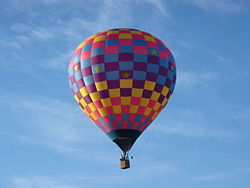Aircraft: Difference between revisions
Jump to navigation
Jump to search
imported>Dan Nachbar m (added another image) |
imported>Dan Nachbar m (added heavier-than-air and lighter-than-air terms) |
||
| Line 9: | Line 9: | ||
are called [[spacecraft]]. | are called [[spacecraft]]. | ||
Most aircraft | ==Types== | ||
Most aircraft remain aloft by pushing air downward, in other words creating | |||
aerodynamic [[lift (force)|lift]], are called heavier-than-air aircraft. | |||
Examples are [[airplane]]s, [[glider]]s, and [[helicopter]]s. | |||
Aircraft | Aircraft remain aloft by using low density gas to create [[buoyancy]], called aerostatic lift, are called lighter-than-air aircraft. | ||
Examples include [[balloon (aircraft)|balloon]]s and [[airship]]s. | |||
[[Category:CZ Live]] | [[Category:CZ Live]] | ||
[[Category:Engineering Workgroup]] | [[Category:Engineering Workgroup]] | ||
Revision as of 21:00, 17 November 2007
Aircraft are vehicles capable of sustained flight within the Earth's atmosphere.
Vehicles that travel beyond the Earth's atmosphere, normally defined as 100,000 meters altitude, are called spacecraft.
Types
Most aircraft remain aloft by pushing air downward, in other words creating aerodynamic lift, are called heavier-than-air aircraft. Examples are airplanes, gliders, and helicopters.
Aircraft remain aloft by using low density gas to create buoyancy, called aerostatic lift, are called lighter-than-air aircraft. Examples include balloons and airships.

